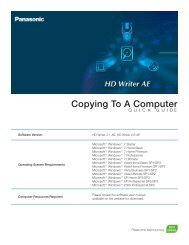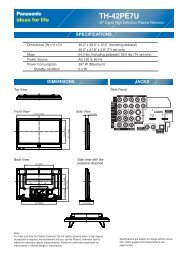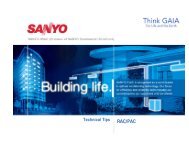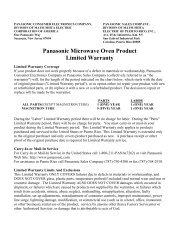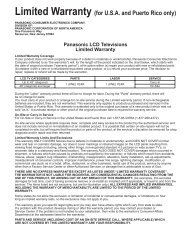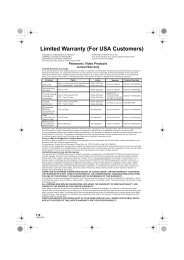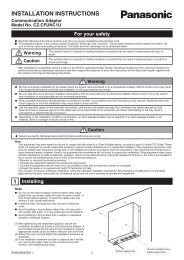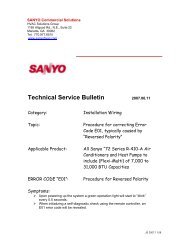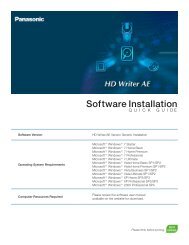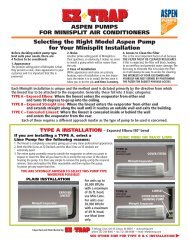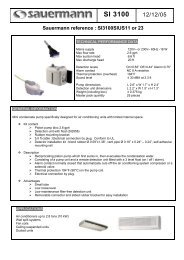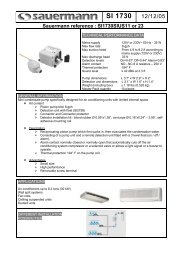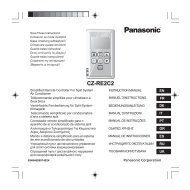Technical Service Bulletin - Panasonic
Technical Service Bulletin - Panasonic
Technical Service Bulletin - Panasonic
You also want an ePaper? Increase the reach of your titles
YUMPU automatically turns print PDFs into web optimized ePapers that Google loves.
SANYO Commercial Solutions<br />
HVAC Solutions Group<br />
1165 Allgood Rd., N.E., Suite 22<br />
Marietta, GA 30062<br />
Tel: 770.977.8510<br />
www.sanyohvac.com<br />
<strong>Technical</strong> <strong>Service</strong> <strong>Bulletin</strong> 2009.10.02<br />
Category: Troubleshooting Procedures.<br />
Topic: Procedures that can be used for routine troubleshooting<br />
along with self diagnostics and the service manual<br />
Applicable Product: All Sanyo 7 series 9,000 to 24,000 BTU Mini Split plus<br />
all Flexi-Multi systems<br />
Symptoms: System has stopped working, there may or may not be<br />
lights displayed on the unit or circuit boards<br />
Probable Cause: Various components or wiring has failed<br />
Diagnostics Checks & Repair: Follow procedures described below<br />
Troubleshooting Procedures<br />
Section 1: No Light on Outdoor Board<br />
Section 2: Flashing light on Outdoor Board<br />
Section 3 - No Lights On at the Indoor Unit<br />
Section 4: Flashing lights on the Indoor Unit<br />
Section 5: Other Items for Troubleshooting<br />
2009.10.02 Ductless Split Diagnostic Procedures for systems of 24k/BTU and less 1
Section 1- No Light on Outdoor Board<br />
A. Check Power Supply.<br />
B. Check the fuse on board. If the fuse is soldered in, by pass it with an in line fuse<br />
holder until the short is located, this includes checking ohms on all components.<br />
Ohm terminals 1, 2 and 3 to ground. Visually check board and for any other possible<br />
shorts. If the fuse was good or bad, proceed to the next steps.<br />
C. Ohm reactor. It should be .3-.4 ohms.<br />
D. Turn the power off and wait for it to dissipate. Disconnect the fan motor,<br />
compressor, crank case heater and the expansion valve from the board. If it is a<br />
flexi model, disconnect the expansion valve board. Turn the power on and check if<br />
the board light is on. If it isn’t, the board is bad. If it is, one of the components is<br />
bad and ohms need to be checked. Proceed.<br />
> Check the fan motor to ground.<br />
> Check through the compressor windings and to ground. A mega ohmer is<br />
recommended because we have seen the DC compressors run (for a short time)<br />
when they are partially grounded. Between all terminals the ohms should be<br />
almost the same, like a 3 phase motor.<br />
> Check the crank case heater.<br />
> Check the expansion valve. Ohm from the grey wire to the other wires in the<br />
expansion valve connector and you should read 46+ or minus 4 ohms.<br />
> On Flexi models visually check the expansion board and ohm any expansion valves<br />
that plug into it.<br />
E. Plug each component back in one at a time until the light starts flashing or the light<br />
goes out and you have most likely found the bad component. Remember to turn the<br />
power off and let it dissipate (about 2 minutes) each time before plugging another<br />
component back in.<br />
Section 2- Flashing light on Outdoor Board<br />
A. Unplug all components and the light should turn from flashing to solid. If it doesn’t<br />
the board is most likely bad. Replace the board but still ohm/check all other<br />
components.<br />
B. Once you have a solid light, plug each component back in one at a time. Remember to<br />
cycle the power and let it dissipate (about 2 minutes) each time.<br />
2009.10.02 Ductless Split Diagnostic Procedures for systems of 24k/BTU and less 2
C. If you plug the fan motor in and this causes the light to flash it could be the board<br />
or the motor. There is no way to tell which one is bad. We would suggest ordering<br />
both parts and plugging the motor in first, to see if this resolves the problem since<br />
it is the easiest to check.<br />
Section 3 - No Lights On at the Indoor Unit<br />
A. Check power supply at terminals 1 and 2. Is there a condensate pump with an open<br />
safety switch? If you have power and the unit will not respond to the remote<br />
proceed to next check. Check that the power relay (on the outdoor unit) is<br />
energized and allowing the power supply to the indoor. It is opened by the high<br />
pressure switch or the compressor overload.<br />
B. Check fuse on board. If the fuse on the board is blown, check all components that<br />
plug into the board. Verify that 220 volts was not run to a 110 volt unit. If this has<br />
happened, replace all boards and the power relay.<br />
C. Try to start the unit with the manual (push button) on off button located in the<br />
bottom right hand corner (K models). If this does not work, change the board and<br />
the receiver.<br />
D. If the unit starts with the button, check the remote for proper addressing. Try<br />
resetting the remote by pushing the ACL button for 3-4 seconds.<br />
E. You can test the remote to see if it is sending a signal with an AM radio. Hold the<br />
remote next to the turned on AM radio and push one of the buttons on the remote.<br />
If you hear interference through the radio’s speaker, the remote is working. Try it<br />
in several locations on the radio before condemning the remote.<br />
F. If the remote checks good but the unit will still not respond to it, replace the<br />
board and the receiver.<br />
Section 4: Flashing lights on the Indoor Unit<br />
A. If this is a new installation, check polarity of the field installed inter connecting<br />
wires between terminals 1, 2 and 3 at the indoor and outdoor units. Also check for<br />
polarity issues caused by a work box, disconnects or a condensate pump.<br />
B. If an indoor or outdoor board has been changed, verify that the power wires that<br />
go to terminals 1, 2, and 3 are landed correctly. There is a schematic inside the<br />
covers of both units.<br />
2009.10.02 Ductless Split Diagnostic Procedures for systems of 24k/BTU and less 3
C. There might be an error code. Use the remote to put the unit into self diagnostic<br />
mode and retrieve the error code. The procedure is explained on the back of the<br />
indoor unit’s cover. It is also in the service manual which can be down loaded at our<br />
web site.<br />
D. If there are communication codes, disconnect the field wire at terminal 3 of the<br />
indoor unit and check for 22-26 volts DC between terminal 3 and 2 (not the wire<br />
and 2). If there is no voltage, replace the indoor board. If the voltage checks good<br />
connect the wire back up and proceed to the next step.<br />
E. Disconnect the wire at the number 3 terminal of the outdoor unit and check for the<br />
same voltage between the wire and terminal 2 of the outdoor unit. Note that if this<br />
is a flexi model it might not be labeled as terminal 3 but, it is the third wire going<br />
to the indoor unit you are troubleshooting. If the voltage checks the same, the<br />
outdoor board is causing the problem. If the voltage is higher, or lower, replace the<br />
interconnecting (14/3 with ground) field wiring.<br />
Section 5: Other Items for Troubleshooting<br />
If the indoor unit is running (the outdoor is off), has a steady green light, and will<br />
not cool. It is most likely locked out on low ambient temperatures. Some models can<br />
be made low ambient using a SANYO Low Ambient Kit containing a board and crank<br />
case heater. NO after market controls will work.<br />
Check your supply voltage with load and no load.<br />
If you are having intermittent problems, verify the power supply is not pulled from<br />
a 3 phase panel. In most cases this does not cause problems but commercial power<br />
supplies could be prone to electrical noises and cause interference issues.<br />
Check for voltage on the ground wire of your power supply. Ground to earth ground.<br />
Verify the 3 wires that go from the board to 1, 2 and 3 are landed properly if<br />
board/boards have been changed. These models are polarity sensitive.<br />
If an outdoor board has been changed, verify that ALL the screws that hold the<br />
board down are in place and tight before running.<br />
Ohm the crank case heater, it should read between 700-1500. This heater can<br />
short out the circuit board.<br />
For additional details please access our technical literature using our website at<br />
http://us.sanyo.com/HVAC or contact our technical service department.<br />
2009.10.02 Ductless Split Diagnostic Procedures for systems of 24k/BTU and less 4



